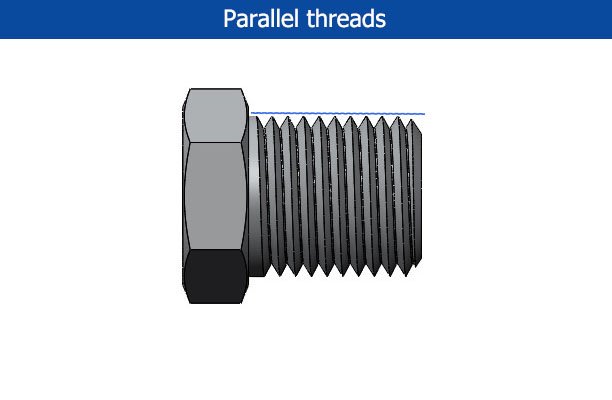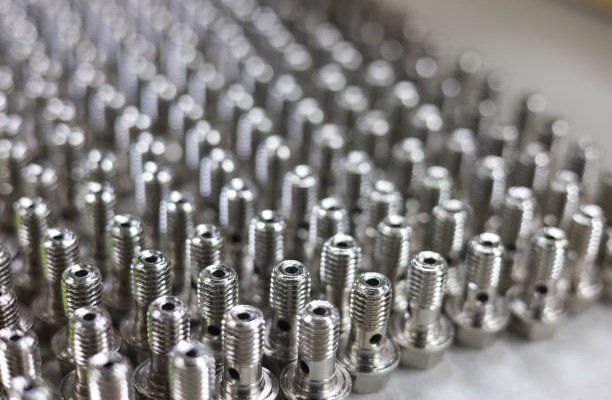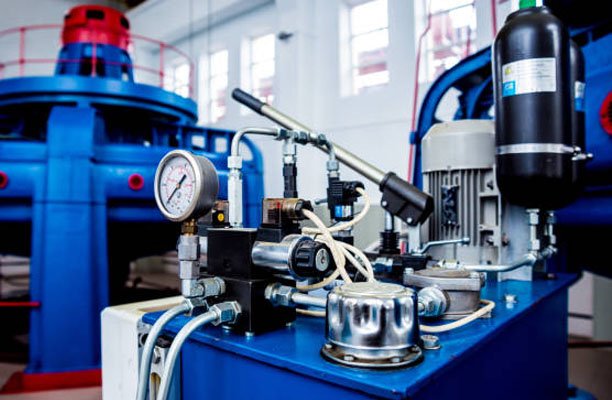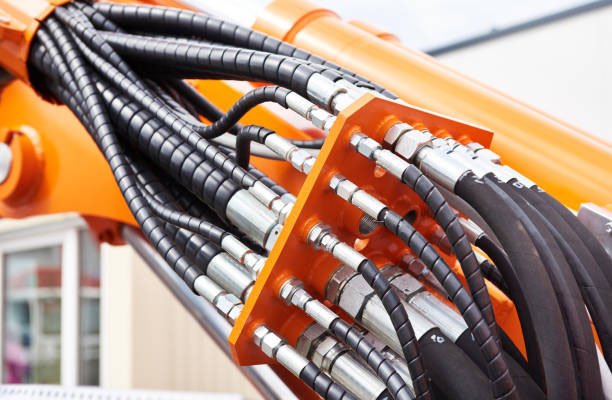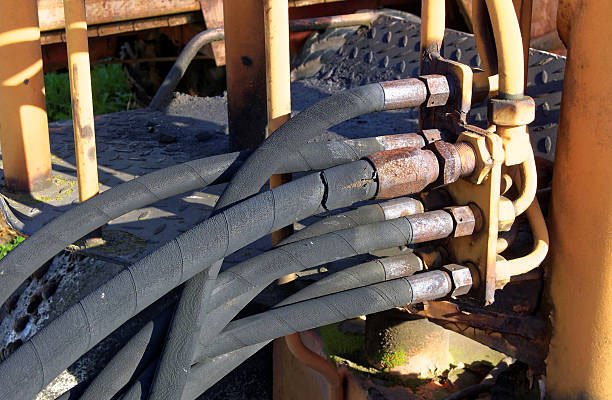Understanding Parallel Threads
What Are Parallel Threads?
Parallel threads, also known as straight threads, are thread profiles where the diameter remains constant throughout the length of the thread. Unlike tapered threads that narrow at the end, parallel threads maintain a uniform profile, which makes them ideal for a variety of mechanical and fluid sealing applications.
These threads are widely used in precision engineering and plumbing, offering reliability in low-pressure environments. Common examples include the ISO 228 (BSPP) and Unified National Thread (UN) types.
Key Characteristics of Parallel Threads
- Constant Diameter: No taper across the thread length.
- Mechanical Strength: Offers stable load distribution.
- Sealing Mechanism: Requires additional sealing materials like O-rings or thread sealants.
- Compatibility: Must match with exact thread size and pitch.
Types of Parallel Threads
Metric Parallel Threads (ISO 228):
Used predominantly in European plumbing systems, these threads don’t self-seal but rely on washers or O-rings.
Unified Thread Standard (UN/UNF/UNC):
Common in North America, available in fine (UNF), coarse (UNC), and standard (UN) threads.
British Standard Pipe Parallel (BSPP):
These threads use a gasket or bonded seal in the coupling face to create a leak-tight joint, ideal for fluid systems.
Differences Between Parallel and Tapered Threads
Understanding the fundamental differences between thread types ensures correct application and prevents failure.
Sealing Mechanisms
- Parallel Threads: Do not seal on the threads themselves. Sealing is achieved using gaskets, O-rings, or thread sealants like PTFE tape.
- Tapered Threads: Seal through thread interference as they tighten and wedge together.
Application-Based Suitability
- Use Parallel Threads: In low to medium pressure hydraulic or pneumatic systems requiring frequent assembly/disassembly.
- Use Tapered Threads: In high-pressure systems where mechanical sealing is critical.
Thread Standards and Classification
Overview of ISO and ANSI Standards
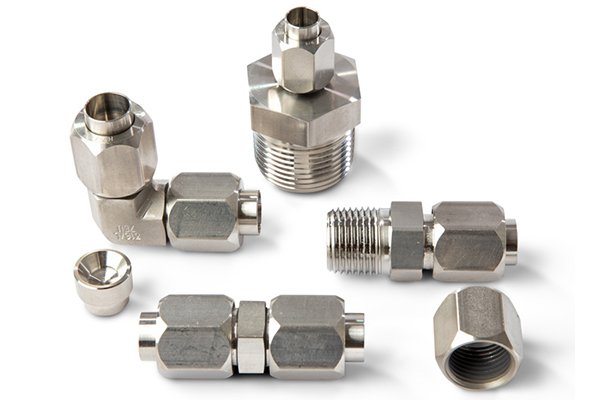
Thread types and standards help standardize fittings worldwide. The most common include:
- ISO 228 (Metric Parallel)
- ANSI B1.1 (Unified Threads)
- BS 2779 (BSPP)
These standards define everything from thread angle to pitch and tolerance, ensuring interchangeability.
Metric Parallel Threads (ISO 228)
Common in water fittings, ISO 228 is non-self-sealing and requires supplementary sealing components.
Unified Thread Standard (UN/UNF/UNC)
Widely used in North America for bolts and screws, these threads have well-defined diameters and pitches suited for precision fastening.
BSPP (British Standard Pipe Parallel)
Essential in the UK and Commonwealth countries, BSPP threads rely on bonded washers for a tight seal.
Material Compatibility and Durability
Choosing the Right Material for Threads
Selecting the right material for parallel threads is just as crucial as selecting the correct size and standard. The environment, pressure, and mechanical load all affect material performance. Common materials include:
- Stainless Steel: Ideal for corrosive environments such as marine or chemical processing applications. Offers excellent durability and resistance to rust.
- Brass: Common in plumbing and low-pressure applications. Brass threads resist corrosion and are easy to machine but are softer than stainless steel.
- Plastic (Nylon, PVC): Lightweight and corrosion-resistant. Best suited for low-pressure applications like irrigation or lightweight systems.
Environmental Resistance and Corrosion
Environmental conditions such as moisture, temperature, and exposure to chemicals can degrade thread performance. Here’s a quick comparison:
| Material | Corrosion Resistance | Temperature Resistance | Best Used For |
|---|---|---|---|
| Stainless Steel | Excellent | High | Marine, chemical plants |
| Brass | Good | Medium | Plumbing, HVAC |
| Plastic | Fair | Low | Irrigation, DIY systems |
When selecting a thread, always consider what the thread will come in contact with — both chemically and mechanically.
How to Select the Right Parallel Thread
Determining Thread Size and Pitch
Thread size and pitch must match exactly for a proper fit. Using mismatched threads can lead to leaks or equipment failure. Use these methods for accurate identification:
- Thread Gauges: Physical tools to measure the pitch and diameter.
- Thread Charts: Standardized charts that provide pitch and diameter correlations based on the thread type.
Measurement Tools and Gauges
Invest in a good-quality thread pitch gauge and calipers for precision. Digital calipers can accurately measure outer and inner diameters, while pitch gauges help you determine the correct threads per inch (TPI) or metric pitch.
Avoiding Cross-threading Issues
To prevent cross-threading:
- Start threads manually before using tools.
- Apply lubricant (if compatible with the material).
- Ensure both male and female threads are clean and aligned before tightening.
Applications of Parallel Threads
Industries That Use Parallel Threads
Parallel threads are utilized across numerous industries, each requiring precision and reliability.
Plumbing and Piping Systems
In plumbing, BSPP and ISO 228 threads dominate. These systems depend on washers and gaskets for sealing, offering flexibility in indoor water supply systems.
Hydraulic and Pneumatic Applications
Hydraulic equipment often uses UNF or BSPP threads for high-precision, leak-free performance in medium-pressure environments.
Aerospace and Automotive Uses
In aerospace, fine threads (UNF) are preferred for vibration resistance and strength-to-weight efficiency. Automotive systems use a mix of UN and metric threads depending on the manufacturer’s location.
Installation and Maintenance Tips
Best Practices for Thread Assembly
Follow these best practices for reliable installation:
- Always inspect threads before use.
- Use appropriate sealing aids (PTFE tape or liquid thread sealants).
- Do not over-torque; follow manufacturer recommendations.
Use of Thread Sealants and Tapes
PTFE Tape (Teflon Tape) is ideal for parallel threads where sealing is needed but not inherent. Liquid thread sealants can fill microgaps and offer more flexibility under temperature changes.
Inspection and Wear Monitoring
Threads should be routinely inspected for:
- Deformation: May occur due to over-tightening.
- Corrosion: Particularly in outdoor or chemical environments.
- Loosening: Especially in high-vibration settings.
Common Mistakes to Avoid
Misidentifying Thread Type
Using a tapered fitting in a parallel-thread system — or vice versa — can lead to serious mechanical failures. Always confirm thread type and standard before installation.
Ignoring Pressure or Load Specifications
Parallel threads are not designed for sealing under high pressure without additional aids. Avoid using them where self-sealing under pressure is necessary.
Advantages and Disadvantages of Parallel Threads
When to Use and When to Avoid
Pros of Parallel Threads:
- Easy to assemble and disassemble.
- Reusable with proper care.
- Safer for soft material applications (plastic or brass).
Cons Compared to Tapered Threads:
- Requires external sealants.
- Not ideal for sealing in high-pressure systems without O-rings or gaskets.
Troubleshooting Thread Issues
Fixing Leaks and Thread Damage
Leaks usually result from poor sealing or thread wear. Here’s how to troubleshoot:
- Reseal with new PTFE tape.
- Replace damaged threads with threaded inserts or bushings.
- Use leak detection fluid to find micro-leaks.
Tools for Thread Repair
- Thread Chasers: For cleaning and realigning threads.
- Heli-Coils: For restoring stripped threads.
- Tap and Die Sets: To recut damaged threads.
Future Trends in Thread Technology
Innovations in Thread Design and Manufacturing
With the rise of additive manufacturing, threads can now be printed directly into complex geometries using high-performance polymers and metals.
3D Printing of Threads
3D printing allows custom threads for prototyping or low-volume production without needing dies or molds, cutting costs significantly.
Smart Fastening Systems
IoT-enabled fasteners now exist that can detect loosening or vibration, especially valuable in aerospace or automotive sectors.
Conclusion
Choosing the right parallel threads for your needs requires a solid understanding of thread types, standards, materials, and applications. While parallel threads offer versatility and ease of use, their effectiveness depends on proper identification, sealing, and maintenance.
Whether you’re working in plumbing, automotive, aerospace, or hydraulics, taking the time to select the correct thread can prevent leaks, improve safety, and extend system life.
FAQs
1. How can I tell if a thread is parallel or tapered?
Check the diameter along the thread length. If it stays the same, it’s parallel. If it narrows toward the end, it’s tapered.
2. Do parallel threads need sealant?
Yes. Unlike tapered threads, parallel threads require PTFE tape, O-rings, or washers for effective sealing.
3. What’s the best material for outdoor use?
Stainless steel is highly resistant to rust and weather, making it ideal for outdoor and marine environments.
4. Can I use parallel threads in high-pressure systems?
Only with proper sealing elements like bonded washers or O-rings. Tapered threads may be better for extremely high pressure.
5. Is BSP the same as BSPP?
Not exactly. BSP refers to the thread family, but BSPP stands for British Standard Pipe Parallel, while BSPT is tapered.
6. What happens if I mix thread types?
Mixing threads can result in poor sealing, cross-threading, or thread stripping — potentially causing leaks or mechanical failure.

